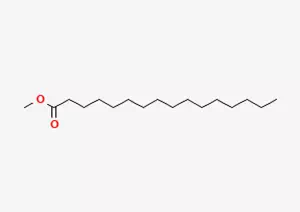Methyl palmitate, as an important organic compound, plays a crucial role in the production of surfactants and other fine chemical products. It is not only one of the key raw materials for these products, but also, due to its unique chemical structure and properties, plays an indispensable role in multiple industrial applications.
I. Application in Surfactants and Fine Chemical Products
The production of surfactants
Methyl palmitate is an important raw material for manufacturing a variety of surfactants. Surfactants are widely used in daily life and industrial production, such as detergents, wetting agents, emulsifiers, etc. They enable two immiscible liquids, such as water and oil, to form a uniform mixture by reducing the surface tension at the liquid interface.
When manufacturing anionic surfactants, methyl palmitate can be used as a starting material. Through a series of chemical reactions, a product with excellent decontamination ability and emulsifying performance is ultimately produced.
Preparation of other fine chemical products
In addition to surfactants, methyl palmitate is also a raw material for many other fine chemical products. For instance, it can be used to produce lubricants, stabilizers, rust inhibitors and plasticizers, etc.
Lubricants can reduce friction and wear during the operation of mechanical equipment and improve work efficiency. Stabilizers can prevent products from decomposing or deteriorating during storage and use. Rust inhibitors can protect the metal surface from corrosion. Plasticizers can increase the flexibility and plasticity of plastics.
Ii. Applications in other fields
The preparation of pheromones
Methyl palmitate can also be used in the preparation of pheromones. Pheromone is a kind of chemical substance secreted by organisms outside the body, which can affect the behavior or physiological response of individuals of the same species. In entomological research, scientists often use methyl palmitate to synthesize pheromones of various insects to study their communication mechanisms and behavioral patterns.
The production of biodiesel
With the increasing demand for renewable energy, biodiesel, as an environmentally friendly fuel, has received widespread attention. Methyl palmitate is one of the ideal raw materials for the production of biodiesel. Through transesterification reaction with methanol, vegetable oil can be converted into biodiesel, and the by-product glycerol produced in this process can also be further utilized.
The application of cosmetic raw materials
Methyl palmitate also has a wide range of applications in the cosmetics industry. It can act as an oil regulator to help adjust the texture and touch of cosmetics, making them easier to apply and absorb. In addition, it also has a good moisturizing effect, which can nourish the skin and prevent water loss.
Preparation of plant acaricides
Methyl palmitate can also be used to prepare plant acaricides. This type of insecticide has a strong contact killing effect on mites and can effectively control the number of mites on crops, thereby protecting the crops from damage. Compared with traditional chemical pesticides, plant acaricides based on methyl palmitate are safer and more environmentally friendly, and will not cause harm to human health.
Iii. As an additive in the food and cosmetics industries
The role of antioxidants
Methyl palmitate can be used as an additive in the food and cosmetics industries. In these industries, it mainly functions as an antioxidant, that is, by slowing down the self-oxidation process of unsaturated fatty acids to stabilize oil products.
Unsaturated fatty acids are prone to react with oxygen in the air, causing oils and fats to oxidize and deteriorate, generating odors and harmful substances. Methyl palmitate can effectively inhibit the occurrence of this process and extend the shelf life of oil products.
Improve product quality
By adding an appropriate amount of methyl palmitate, the quality of food and cosmetics can be significantly improved. For example, adding a small amount of methyl palmitate to edible oil can not only prevent the oxidation and deterioration of the oil, but also improve its taste and flavor. Adding methyl palmitate to skin care products can make them more gentle and non-irritating, making them suitable for sensitive skin.
In conclusion, methyl palmitate, as a multifunctional organic compound, plays a significant role in the production of surfactants and other fine chemical products. Meanwhile, it also has broad application prospects in fields such as pheromones, biodiesel, cosmetic raw materials, and plant acaricides. In addition, as an antioxidant additive in the food and cosmetics industries, methyl palmitate can also effectively enhance the quality and safety of products. Therefore, in-depth research and development of the application potential of methyl palmitate are of great significance for promoting the development of related industries.




